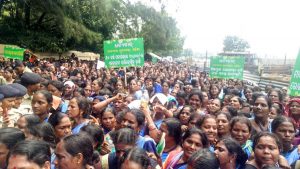
 By Abhipsa Ray and Prof Satya Narayan Misra* in Bhubaneswar, August 20, 2022: At the height of the emergency (1975), Mrs. Gandhi launched the Integrated Child Development scheme with the avowed objectives of improving nutrition among children, pregnant and nursing mothers, providing basic healthcare, and also educate children in the age group of 4-6 years before they enter into the portals of formal learning.
By Abhipsa Ray and Prof Satya Narayan Misra* in Bhubaneswar, August 20, 2022: At the height of the emergency (1975), Mrs. Gandhi launched the Integrated Child Development scheme with the avowed objectives of improving nutrition among children, pregnant and nursing mothers, providing basic healthcare, and also educate children in the age group of 4-6 years before they enter into the portals of formal learning.
The fulcrum of this humungous program for nutrition and basic healthcare is 22 lakh Anganwadi workers in 14 lakh Anganwadi centers. 30 years later the government felt it to be prudent that the National Rural Health Mission must include more robust health architecture by appointing Accredited Social Health Activists (ASHA) in 2005 with a view to acting as an interface between the primary health care centers and the community at large.
They were imparted training to meet the unforeseen scourge of COVID-19. The ASHAs were included as the front-line workers in an attempt to prevent the community-level spread of the virus in addition to their usual tasks of maternity and child healthcare and nutrition.
A study was undertaken to make an assessment of how the ASHA workers have been able to cope with the challenge of COVID 19 and to what extent the training imparted to them has been effective. The ASHA workers’ expanded duty as front line warriors put them under a lot of stress, challenges, hardships, and constant fear of getting infected themselves as well as their families. They bore the high risk of getting infected themselves as well as their family members but that did not dim their spirit of serving the community.
A survey conducted by OXFAM India in four states (Uttar Pradesh, Odisha, Bihar, and Chhattisgarh) cites the dreadful working condition of ASHAs where only 23% of ASHAs were provided with protective bodysuits, only 75% had masks and 62% had gloves to perform their duties and many of them reported not receiving any training on how to use the PPEs on the field.
 Despite so much work, the ASHAs get a meager amount of payment. Most of the ASHAs get only around 3500-5000 rupees per month. More than two-thirds (67 percent) highlighted irregularity in the payment of their salaries which were paid cumulatively in 3-4 months. All the ASHAs have undergone a training program one day prior to performing the Covid duty and they received on-the-job training from time to time on the basis of revised guidelines or Covid protocols.
Despite so much work, the ASHAs get a meager amount of payment. Most of the ASHAs get only around 3500-5000 rupees per month. More than two-thirds (67 percent) highlighted irregularity in the payment of their salaries which were paid cumulatively in 3-4 months. All the ASHAs have undergone a training program one day prior to performing the Covid duty and they received on-the-job training from time to time on the basis of revised guidelines or Covid protocols.
They were trained on the usage of PPE kits, personal safety measures and hygiene protocols for the community, usage of generic medicines, protocols to be followed during home isolation and awareness about early symptoms, and the importance of social distancing. They also played a very critical role in keeping a track of high-risk categories like screening migrants, attending to patients with symptoms, and following up on their health. 95 percent (53% agreed while 42% strongly agreed) of the ASHAs interviewed were convinced that the training provided them with the requisite knowledge and information to perform their duty with proficiency.
They reported no issues faced during the training sessions. That is the reason why 68 percent found the training program to be highly effective. ASHA Workers were provided with a PPE kit from PHCs. Only sanitizers and masks were made available to them. Other essential items like Oximeter, cap, gloves, spectacles etc. had to buy from the fund (Rs. 10,000/-) provided by the state government.
Even the masks which were provided were of poor to very poor quality as reported by the majority of the Asha workers (42 percent said masks were of very poor quality while 9 percent put it under the poor category). Only 15 percent thought masks were of very good quality. When enquired about the challenges and the issues faced by the community while discharging their responsibility, ASHA workers informed that while they faced high community resistance during the first wave, it gradually eased out with time.
However, a quarter of them pointed out towards no cooperation were received from the families having migrants. It was reported that they didn’t voluntarily inform ASHAs when they arrived from different cities or places. There were also instances of lower co-operation during Migrant quarantine.
The findings from the SERVQUAL model analysis showed that ASHAs were highly reliable in providing healthcare services and conducting door-to-door surveys. They have not only played a crucial role in controlling community-level spread but also effectively driven the mass vaccination campaigns, assured and removing the fear of the beneficiaries.
As the beneficiaries were not able to visit the hospitals for regular health check-ups much during the pandemic; the ASHAs brought the services to their doorstep for the convenience of the beneficiaries effectively. The beneficiary respondents reported that the ASHAs have been empathetic as well as responsive.
Sumitra Beshara, the ASHA worker of Chirgatola-2, Bhubaneswar was reported to provide rations and other essential items to a COVID-affected family by collecting donations from the community. Snehalata Pradhan, ASHA worker of Kesura reported that she has attended an emergency case at 2 AM in the night. The ASHA worker of Shikharchandi area, Mamata Manjari Bhoi reported how she had taken a malnourished child, belonging to a disturbed household of an alcoholic father, to the doctor and got him treated. 72% of the beneficiaries interviewed responded that the ASHAs have provided greater service in the time of pandemics.
 COVID-19 has proved that these women can be much more than just Accredited Social Health Activists in long term. With proper training, better remuneration, and skill development, the ASHAs can be extremely beneficial in providing more healthcare facilities at the doorstep of the
COVID-19 has proved that these women can be much more than just Accredited Social Health Activists in long term. With proper training, better remuneration, and skill development, the ASHAs can be extremely beneficial in providing more healthcare facilities at the doorstep of the
beneficiaries and improving the health status at a community level. Providing them with better working environments will boost their morale and motivate them to work as front-line warriors.
Technology can be a useful tool in the hands of ASHAs in keeping track of beneficiaries immunizations, health charts, etc. which will lessen their work burden. However, all the ASHAs reported that they couldn’t find any significant use of the JAM (Jan Dhan, Aadhaar, Mobile ) trinity. Moreover, 96 percent of respondents ASHAs couldn’t make any use of the Arogya Setu app as they didn’t have smart phones.
Almost all ASHAs weren’t aware of the technological interface and other tech support systems. As India steps into its 76 years of independence Government, its basic health care structure needs to be significantly ramped up. COVID-19 has been a timely wake-up call. The inspiring story of the ASHA heroes needs support in terms of better remuneration, technological support & a more empathetic society.
We need a society-led approach where the government, corporates, and local community activities in tandem, instead of leaving it to the government. ASHA workers can be the pied pipers between the dispensaries and the community at large.
*Prof. S.N. Misra is Professor Emeritus, KIIT University, Bhubaneswar.
Abhipsa Ray, who made field survey of ASHA workers at the height of COVID-19, is Research Scholar, KIIT University.



Leave a Reply
Be the First to Comment!